Healing Your Nervous System After Narcissistic Abuse
Living in survival mode for too long takes a toll. And if you've been through narcissistic abuse, chances are, your nervous system has been running on high alert—stuck in fight, flight, freeze, or fawn.
You might feel jumpy even when nothing is wrong. Or maybe you go numb in situations that should feel safe. It’s not in your head. It’s in your body.
As Lynn Nichols explains in 8 Ways to Regulate Your Nervous System After Enduring Narcissistic Abuse Trauma, survivors often experience dysregulation that leads to symptoms like anxiety, hypervigilance, difficulty concentrating, and even physical issues such as disrupted sleep and muscle tension. Nichols emphasizes that regulating the nervous system reduces hyperarousal, strengthens resilience, and creates space for trauma processing. Practical techniques such as mindfulness, grounding exercises, and gentle movement can help survivors rebuild emotional clarity and restore a sense of safety in their bodies.
Let’s talk about what it means to slowly, gently rebuild your nervous system after narcissistic abuse. This process is a vital part of the trauma recovery journey and often aligns with the early steps in the 4 stages of trauma recovery.
1. Understand What Happened to Your Body
Narcissistic abuse isn’t just emotional—it’s physiological. Your body learned to stay on guard to protect you. This constant stress response creates dysregulation in your nervous system due to narcissist abuse cycle.
Signs your nervous system is dysregulated:
Trouble sleeping
Chronic anxiety or shutdown
Difficulty concentrating
Feeling disconnected from your body
Naming it helps. You’re not crazy or broken. You’ve been in survival mode.
Many survivors of narcissistic abuse experience PTSD-like symptoms. In fact, ptsd from narcissistic abuse is a growing area of focus in trauma therapy.
Understanding the effects of narcissistic abuse, such as emotional numbness, hypervigilance, and trust issues, can help normalize your experience. These are common symptoms of narcissistic abuse and not personal flaws.
2. Start with Safety Cues
Your body needs to learn what safety feels like again. Not just "not unsafe"—but genuinely safe.
Daily ways to signal safety to your nervous system:
Listening to calming music
Wrapping yourself in a soft blanket
Petting your dog or cat
Breathing slowly with your hand on your chest
It might feel awkward at first. That’s okay. You’re building a new relationship with your body. Therapies like cognitive behavioral therapy and cognitive processing therapy help reframe traumatic memories and restore a sense of safety. If you're searching for support, a trauma-informed therapist can guide you through these techniques.
For those healing from covert narcissistic abuse, learning safety cues is especially important because the abuse may have been subtle and deeply confusing.
3. Practice Gentle Grounding
You don’t need to meditate for an hour to start feeling better. Try:
Splashing cold water on your face
Lying on the floor and noticing the weight of your body
These grounding tools help bring you back into the present and out of survival mode. Grounding exercises are often introduced in the early phases of cognitive behavioral therapy for anxiety, which is widely used in trauma treatment.
If you're navigating relational trauma recovery, grounding becomes an anchor, reminding your body that not every moment demands vigilance.
4. Move in Ways That Feel Good
Trauma lives in the body, and movement can help release it. You don’t need a gym membership or a routine. You just need to move in ways that feel safe:
Stretching
Walking in nature
Rocking back and forth
Dancing by yourself in your room
Let your body take the lead. Rebuilding your nervous system isn’t about control; it’s about curiosity. Movement-based healing can be especially powerful for those recovering from childhood sexual trauma in adults, as the body often stores memories that the mind has suppressed.
For many, combining movement with emdr for sexual trauma or somatic therapy provides deeper relief.
5. Honor Rest as a Healing Practice
After abuse, rest can feel unfamiliar, even guilt-inducing. But your nervous system needs it. Rest isn’t lazy. It’s essential. Curling up with a book, napping, and staring out the window are acts of trauma recovery. If your body feels safe enough to rest, that’s a huge sign of healing. Those healing from narcissistic abuse syndrome may struggle with feelings of unworthiness when resting. Therapy can help reframe these beliefs.
A Safe Path Back to Yourself
Healing after abuse takes time. Rebuilding your nervous system is not a one-and-done task—it’s a collection of small moments where you choose presence over panic. Kindness over chaos.
And if you’re looking for support while you do this, my Trauma Healing Membership is a safe space to learn, grow, and feel seen by others who get it. Working with a narcissistic abuse therapist or joining a narcissistic abuse support group can give you the tools to move forward.
You deserve to feel safe in your body again.
FAQs
How does narcissistic abuse affect the nervous system?
Narcissistic abuse can keep your nervous system in survival mode, leading to chronic stress, hypervigilance, and emotional exhaustion. Over time, this dysregulation can cause anxiety, fatigue, and physical tension that make healing difficult.
How can I heal my nervous system after narcissistic abuse?
Healing your nervous system after narcissistic abuse involves calming the body through grounding, mindfulness, breathwork, and trauma-informed therapy. These practices help restore safety and regulate emotional responses.
How long does it take to regulate your nervous system after trauma?
Recovery from nervous system trauma varies, but consistent self-regulation practices and therapy can help you notice improvements within weeks. Healing is gradual, focusing on restoring balance and emotional safety.
What are signs your nervous system is healing from trauma?
You may notice calmer reactions, improved sleep, and less anxiety when your nervous system is healing. You’ll begin to feel more grounded, present, and emotionally resilient in everyday situations.
Can mindfulness help with nervous system recovery after abuse?
Yes, mindfulness for nervous system recovery helps calm stress responses, release body tension, and rebuild a sense of control. Combined with therapy, it’s an effective tool for narcissistic abuse recovery.


